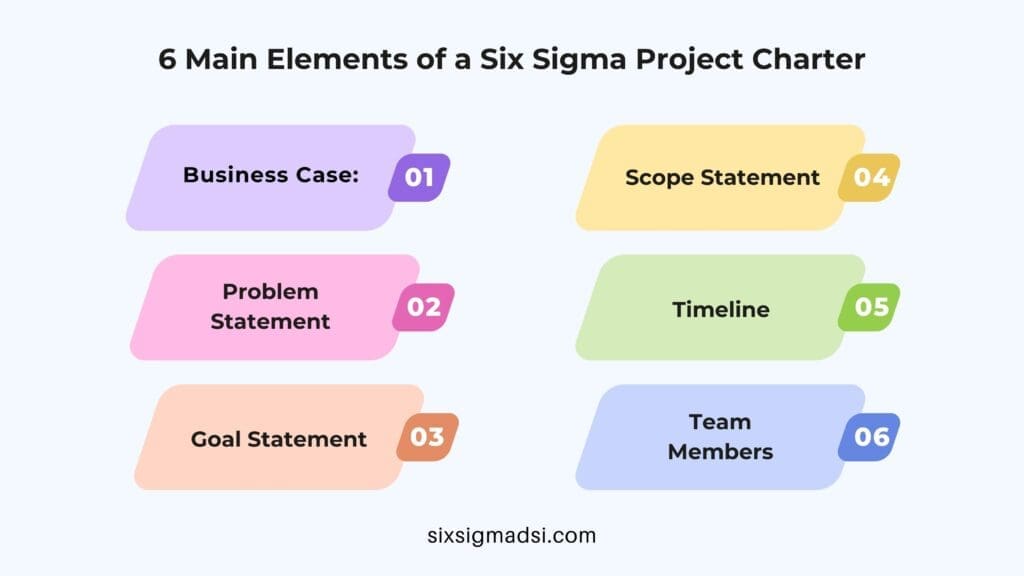Table of contents
How do you start your Project Charter?
How do you start your Six Sigma Project Charter? Identify and understand the problem. When we solve a problem, we tend to “put the fireman’s suit on, grab the hose and run into the burning building”. We douse the flames but unknowingly leave embers. Soon after, those embers flare up again and the fire erupts (the problem returns).
We do not tend to follow any formal problem-solving technique when solving process problems. Therefore, we fight the same fires over and over. As we all know, doing the same thing repeatedly and expecting different results is the definition of “insanity”.
The Six Sigma DMAIC Methodology is a way to avoid this insanity. The first step in a Six Sigma Project should always be the Project Charter.
“Plan your Work, and then Work your Plan”. This is the mantra of the Six Sigma practitioner when developing a project charter. The Project Charter is the guideline for the entirety of the Six Sigma Project.
6 Main Elements of a Six Sigma Project Charter

Business Case:
The business case describes why this project is important to the company. Why should the organization support this project?
Problem Statement:
The problem statement contains a brief description of the “pain” being experienced by the organization. The Problem statement should be related to the Voice of the Customer (whether internal or external).
Goal Statement:
What is the goal of the project? How much improvement is targeted? The goal of the project should be specific, measurable, attainable, relevant, and time-bound (SMART Goal). The project goal should be related to the problem you are trying to solve.
Scope Statement:
The scope of the project clearly describes the physical boundaries of the project. The Scope defines what is included in the project and what is excluded in the project. A scope can include product families, geographical areas, departments, etc.
Timeline:
The timeline describes the key milestones and when they will be completed. Typically for a DMAIC Six Sigma project, the times for the completion of each of the five phases (Define, Measure, Analyze, Improve, and Control).
Team Members:
The team members’ section includes all the resources that are required to work on this project. Typically, mentioned in this section are the project sponsor, key stakeholders, team members, and subject matter experts.
When I describe the project charter to students, I use the analogy of “planning a race”. The charter is where you define the starting line and the finish line. You also define the purpose and the route of the race.

I relate the “purpose of the race” to the Business Case on the charter. The Business case is where you start to understand the urgency of the project. The Business Case defines: Why is the project worth doing? Why is it important to do so now? What are the consequences of not doing this project?
A good Business Case Connects the project to the strategic priorities (KPIs) of the business.
- How will this project drive business initiatives and goals?
- How will this project impact the customer, internal and external? The Stakeholder?
- What are the expected financial benefits (revenue increase and/or cost reduction)?
A good template to use when developing a Business Case for a Six Sigma Project Charter is:
“From _(time1)_ to _(time2)_, we have experienced _(pain metric)_. With a target of _(target metric)_, this gap of _(# leads)_ to a Cost of Poor Quality of _($$)_.”
The “starting line” is the Problem Statement. The Purpose of the Problem Statement is to clearly Define and Quantify (using Metrics) the Current State (problem or opportunity).
Example “Problem Statement”
In the last six months, 20% of our repeat customers paid their invoices over 60 days late. The current rate of overdue payments is up from 10% in 2015 and represents 30% of outstanding receivables. This affects our operating cash flow by $259k.
Two things you should never see in a Problem Statement in a Project Charter are:
- Assigning Blame.
- Solutions to the Problem (if you know the solution, there is no need to waste time on a Six Sigma Project).
For example, “Invoices are over 60 days late because of our antiquated ERP system. We need to evaluate upgrading to the newest version”.

The “finish line” is the Goal Statement or Objective Statement. The Goal Statement defines the expected improvement the team is seeking to achieve in clear, concise, and measurable terms.
Goal Statement
- SMART (Specific, Measurable, Attainable, Relevant, and Time-Bound)
- Does not assign blame, presume cause, or prescribe a solution
- Starts with a verb (reduce, achieve, control, increase)
An example of an effective Goal Statement:
Increase (<-verb) employee motivation survey scores (<-what is improved) from the current 42% to 70% (<-improvement and gap) by the end of the 3rd. Quarter 2005 (<-completion date).
Finding the Right Scope
The “Route” of the Race is related to the Scope. The scope focuses on the boundaries and resources of the improvement efforts.
If the scope has not clearly been defined, projects are subject to scope creep resulting in projects that stall indefinitely. The scope can include geographies, products, departments, customers, and start and stop points of the process.
It is important to understand that the Six Sigma Project Charter is a “living document”. The Charter will be revised as you gain more knowledge about the project. Your Problem Statement, Goal Statement, and Scope could change as you progress through the DMAIC roadmap.




















A common omission in the control step of DMAIC is coaching to build the new solution into a habit.
A very good article , has the project charter to be signed from all team members or not to be consider a very formal document
A very good article. I’ld like to keep in touch with sixsigmamadsi.com
Hello, what happen if the owner of the project does not have a defined metric in problem statement? Does not have the performance metric has been affected.
Should we stop here or keep going with the project?